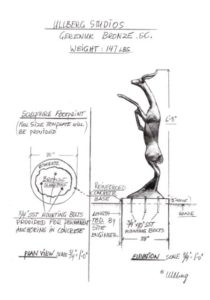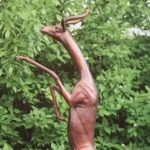Gerenuk
Ullberg spent 7 years in Africa studying, and chose this piece because he found the gerenuk to be an exotic and interesting antelope. He found it exciting to depict him reaching up, standing on his skinny back legs, which challenged the stretched integrity of the composition. Because of this, Ullberg had to include special engineering tricks such as embedding stainless steel structures in the bronze.

By Kent Ullberg
Kent Ullberg is recognized as one of the world’s foremost wildlife sculptors. He studied at the Swedish University College of Art in Stockholm and worked at museums in Germany, the Netherlands, France, Africa and Denver, Colorado. After living in Botswana, Africa, for seven years he has made his home permanently in the United States where he now lives on Padre Island, Corpus Christi, Texas. He also maintains a studio in Loveland, Colorado.
View all sculptures by this artist.Donated By
Betsy and Clifton RobinsonDid You Know?
- Gerenuk means “giraffe-necked” in Somali.
- Gerenuks require very little water and can suvive even in desert conditions.
- Gerenuks are herbivores (plant-eaters). Their diet is based on leaves, shoots, flowers and vines. In dry dry habitats, gerenuks extracts all the moisture they needs from their food.
- They have an excellent sense of hearing, smell, and eyesight.
- Gerenuks have scent glands on their knees, which are covered by tufts of hair.
- They are very vocal. Gerenuks can utilize several vocalizations, including a buzzing sound when alarmed, a whistle when annoyed, a loud bleat when in extreme danger, and a soft bleat when mothers communicate with their young.
At The Zoo
- Born on October 21, 2019, Drax the Destroyer was named after a Marvel Comics character.
- Drax and his parents are among just 50 Gerenuks at 10 zoos across the United States.
Location


